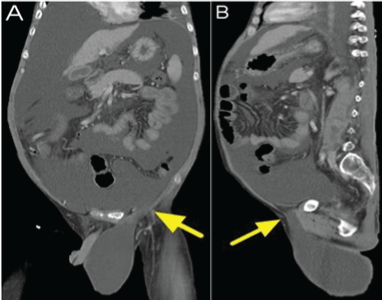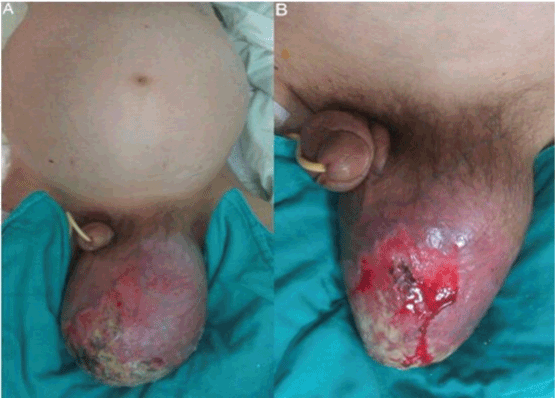A Bleeding Giant Abdominoscrotal Hydrocele
Li-Hsiang Chen and Ching-Chang Leeki
| Li-Hsiang Chen and Ching-Chang Leeki* Department of Medicine, Kaohsiung Armed Forces General Hospital, Kaohsiung, Taiwan |
| Corresponding Author: Ching-Chang Lee,Department of Medicine, Kaohsiung Armed Forces General Hospital, Kaohsiung, Taiwan. Tel: +886-921-404-953 E-mail: tsgh11@gmail.com |
| Received: November 03, 2015 Accepted: December 14, 2015 Published: December 21, 2015 |
| Related article at Pubmed, Scholar Google |
Visit for more related articles at Medical Case Reports
Abstract
Keywords |
||||||
| Abdominoscrotal hydrocele (ASH); Liver cirrhosis; Ascites; Scrotal bleeding | ||||||
| A 43-year-old male with alcoholic cirrhosis presented with a 6-month history of progressive abdominal distension and swelling of the left scrotum. Physical examination revealed a transilluminated, nontender, 23 × 27-cm abdominoscrotal hydrocele (ASH). Intermittent bleeding from the scrotum was noted on post-admission day 11 (Figure 1A). We consulted a genitourinary surgeon and initiated local treatment involving the placement of simple interrupted sutures (Figure 1B). Abdominal computed tomography revealed massive ascites in the peritoneal cavity, communicating with the left scrotum, which contributed to the ASH (Figure 2A and 2B). We applied epinephrine solution, silver sulfa cream on sterile gauze pads (12.5 cm × 20 cm), and an elastic gauze bandage over the bleeding sites, which successfully controlled the bleeding. Because of the presence of massive ascites due to liver cirrhosis, we administered diuretics (furosemide and spironolactone) and albumin, transfused fresh frozen plasma, and performed repeated abdominal paracentesis. After 4 weeks of aggressive treatment, the volume of the hydrocele finally decreased (Figure 3A and 3B). | ||||||
| The ASH in the present case was hourglass shaped and filled with abdominal components communicating with the scrotum through the inguinal canal [1]. The pathogenesis of ASH in most cases is characterized by the abnormal secretion of fluid from the tunica vaginalis, which causes progressively increasing pressure within the scrotum. Fluid is transmitted through the internal inguinal ring to the abdominal cavity, resulting in expansion superiorly, in accordance with Laplace's law [1-3]. In this case, the volume of ascites flowing from the abdominal cavity to the scrotum increased the pressure within the scrotum. Spontaneous bleeding may have resulted from the injury to the superficial scrotal capillaries due to the unbearably high pressure within the scrotum. The possibility of scrotal bleeding due to other causes such as angiokeratoma [4], hematocele, and varicocele formation were excluded. In most cases, surgical treatment of the ASH is recommended. However, surgery was contraindicated in our case due to coagulopathy caused by the liver cirrhosis. Therefore, only local treatment with sutures to control the bleeding was performed. | ||||||
Figures at a glance |
||||||
|
||||||
References |
||||||
|
Select your language of interest to view the total content in your interested language

Open Access Journals
- Aquaculture & Veterinary Science
- Chemistry & Chemical Sciences
- Clinical Sciences
- Engineering
- General Science
- Genetics & Molecular Biology
- Health Care & Nursing
- Immunology & Microbiology
- Materials Science
- Mathematics & Physics
- Medical Sciences
- Neurology & Psychiatry
- Oncology & Cancer Science
- Pharmaceutical Sciences



